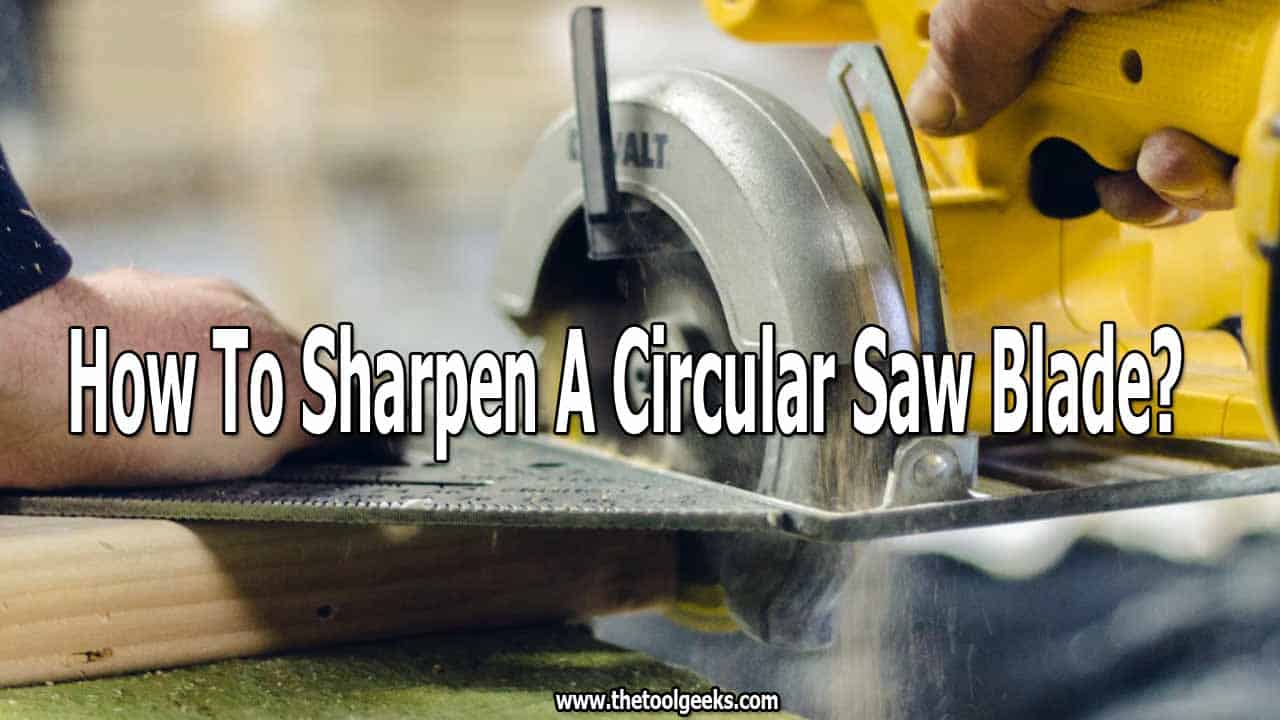How To Sharpen A Circular Saw Blade: Using Your Hands Or Using Dremel
TheToolGeeks.com is a participant in the Amazon Services LLC Associates Program and other affiliate advertising programs. We may earn from qualifying purchases. (Learn More).
Oops! Your circular saw blade has gotten dull, making it difficult for you to make precise cuts. Not to worry, this post will highlight the step by step guide on how to sharpen a circular saw blade, and the tools required to perform the task, so keep your eyes glued to your screen.
What is a circular saw?
A circular saw is an important power tool for just about every professional woodworker or carpenter. The versatility of the tool makes it suitable for a wide range of cuts and other woodworking projects, which is why the tool is seen in every carpentry shop.
Why does a circular saw blade need to be sharpened?
Just as other power tools, the circular saw makes work easier, faster, and more accurate. There is a bit of a downside to the circular saw.
As a result of constant friction, while using the circular saw blade to make cuts through a variety of materials, the blade eventually gets dull.
A dull blade has no use. It makes your work uneven, stressful, noisy, and just plain difficult. For this reason, you are required to sharpen the blade occasionally to make it efficient and as good as new. Click here to see our reviews.
How to know when your circular blade is blunt?
These are indicators that show when a blade has gotten dull.
- Bad cuts: a blunt or dull circular saw blade equals uneven cuts on your material.
- Burn marks: when burn marks start to appear on your blade, then it means the blade has gone dull. The burn marks appear because your dull blade needs more power to cut through the material. In simpler terms, burn marks occur because of relatively more friction.
- Chipping: this refers to the tiny pieces of the blade that breakout while cutting because the blade is fighting to get through the material.
- Noise from the motor: a blunt blade needs more power to make cuts that would have been easier with a sharper blade. This increased force is generated by the motor. This means the motor has to work or spin the blade twice as fast which leads to a noisier workstation.
Tools needed to sharpen a circular saw
You need the following tools to make your sharpening task easier and faster.
- A safety gear. The sentence; “sharpen a circular saw” is enough indication that you need safety gear while trying to execute the task. To sharpen a saw without getting hurt, you need a good old pair of leather gloves, a pair of goggles, and a first aid box just in case an accident occurs.
- A wrench
- Rags
- Chalk or marker
- A Dremel
- A diamond sharpening stick or a mini tapered file
- A diamond disc
Methods of sharpening your circular saw blade
There are two common methods used to sharpen a circular saw blade. You can sharpen the blade;
- Using a Dremel: a Dremel is a hand-held rotary tool with a range of attachments.
- By hand: It’s also possible to sharpen your circular saw by hand, using a sharpening stick or a file.
Related Read — Review of Electric Circular Saws
How to Sharpen a Circular Saw Blade by Hand?
Sharpening a circular saw blade by hand is a tad different from using a Dremel. When using your hands, it is advisable to leave the blade in the machine.
Turn The Blade Off
Put on your safety gear (gloves) and switch off the machine. It doesn’t matter how blunt your blade is, if you leave the machine on while attempting to sharpen the blade, you can accidentally press the trigger button causing the blade to spin and cut you. So, ensure the blade is turned off.
Pick A File
Pick out an appropriate file and apply a few drops of oil or lubricant to it. For this task, a diamond sharpening stick or a mini tapered file is advisable.
The sticks are handy and affordable. You can use “lapping fluid” to lubricate the sharpening stick. The reason for applying oil on the diamond sharpening stick is to ensure smooth movement. Friction between metals can be noisy and ineffective in this case.
So, it’s important to use a lubricant to ensure the stick sharpens the blade effectively. Don’t add too much lubricant because the sharpening stick will just slip off the teeth of the blade without sharpening it. Just add a drop or two.
Related Read — Cutting Thick Wood With a Circular Saw
Pick Your Sharpening Stick
This is a step that involves a little bit of a decision on your end. You can decide to use the diamond sharpening stick on its own or you can mount the stick onto a long piece of wood.
The variation with both methods is because the diamond sharpening stick usually comes with a short blade or sharpener (the metal that does the sharpening). If you are using the stick itself, you need to be careful because too much pull or push of the stick, and you might accidentally brush your hand against the blade.
If you don’t have gloves on, it can be a nasty cut. For this reason, most professional woodworkers advise beginners to glue, tie or mount the diamond sharpening stick on a piece of wood so you have more room and a longer handle to work with.
Mark The Tooth You Started From
Use a marker or chalk to mark the tooth where you are starting from. A blade comes with many teeth and if you don’t mark which tooth you started with, you can lose track of which tooth you have sharpened and which you haven’t.
Start Sharpening
Gently place the lubricated diamond sharpener on the sharp end of the tooth you want to sharpen. Then slowly move the sharpener back and forth.
Usually, three or four strokes should effectively sharpen your blade, but you might want to add a few depending on the material you are working on.
When you are sure the blade is well sharpened, clean it and plug in your saw and continue your work
The beauty of sharpening by hand is that you don’t have to worry about removing the blade. You can sharpen while the blade is fixed in. However, remember to be careful with the sharpener.
Related Read — Using a Circular Saw Without a Table?
How to Sharpen a Circular Saw Blade Using a Dremel?
Unlike using a file or sharpener, sharpening your blade with a Dremel requires you to take off the blade.
Turn Off The Saw & Remove Blade
Turn off the saw and lock the blade to prevent movement. Remove the blade. Most modern circular saws have a “blade release switch” that makes this process easier.
If yours doesn’t have this feature, you need to use a wrench to loosen the screws holding the blade in place. Some saws come with a custom wrench that allows you to loosen the screws.
If you don’t have this, don’t get worked up. Just find a wrench that fits the screw tightly and turn it. Remove the screw and the washer, and then you should be able to take out your blade.
Mark The Tooth You Started From
Place your blade down and mark the first tooth you want to start with, so you don’t lose track. Attach your diamond disc onto the Dremel. The diamond disc is more equipped for sharpening and cutting tough objects.
Related Read — How to Cut Plexiglass With a Circular Saw?
Start Sharpening
With your diamond disc firmly attached, you are ready to sharpen. Put your blade down by placing it on its side. Plug-in your Dremel if you are using a corded Dremel and turn it on.
Apply a little pressure on the trigger button. The disc should start to spin. Carefully place the spinning disc against the marked tooth for about 2-3 seconds and move on to the next tooth.
You might want to feel the tip of the sharpened blade very carefully to ensure it is well sharpened. Do this for all the teeth on your blade.
Attach The Blade Back
When you are satisfied with the result, attach your blade back to the saw. To do this, slide the blade cover backward, fix in the blade and screw it in.
This is the same process you followed when removing the blade. Only now, you are doing it in reverse.
Make a Test-Run
When the blade is perfectly firm, unlock the blade and turn on your saw for a test run. The blade should be sharp enough to continue your task.
Conclusively, while sharpening a blade either with a Dremel or with a file, you need to take note of each tooth, its shape, the direction it’s facing, and the bevels, so you do not sharpen the wrong edge. Also, you might want to consider sharpening both sides of your blade. It allows for more effectiveness while sawing.
Follow any of the methods above and you should have a circular saw blade that will be as good as new. Ensure to let us know if this post helps you achieve your desired results by leaving a comment.
Have a nice saw-sharpening experience.
Amazon and the Amazon logo are trademarks of Amazon.com, Inc, or its affiliates.

